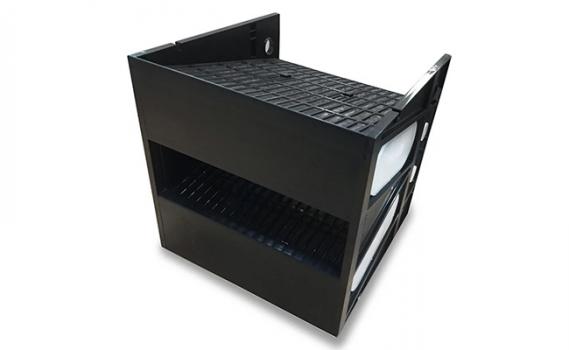CamCarb VG Molecular Filters
Description
CamCarb VG modules with loose-fill media are robust solutions suited for make-up air (outdoor air) and recirculation air systems. The primary use is the control of acidic gases that are responsible for the corrosion of electronics and electrical equipment in heavy process industries such as pulp and paper mills, petrochemical refineries, mining and metal refining operations, and wastewater treatment plants. They are also suitable for lighter applications such as the removal of noxious and odorous fumes generated outside airports, hospital helipads, cultural heritage buildings, and commercial offices located in city centers. The modules can be filled with different types of Camfil molecular filtration media to suit the specific customer application.
There are two standard configurations of CamCarb VG: VG300 and VG440. The VG300 format is best suited for moderate duty (normally make-up air) applications and the VG440 is best suited for light-duty (recirculation air) applications. CamCarb VG filters can be installed in specially designed housings, with options for front-loading, side loading, or positive seal side access (PSSA). They can also be used as replacements in housings and track systems produced by other manufacturers.
CamCarb VG modules are fully welded and constructed without adhesive to eliminate the possibility of off-gassing. They include a unique molded mesh to allow the use of a full range of loose-fill media without shedding. Many applications will require multiple molecular media to address a range of contaminants. The different media should be deployed in a series of layered modules. This layered approach will provide the highest removal efficiency, the longest life, and the lowest total cost of ownership (TCO) as each media can be changed when it reaches the end of its useful life. Whereas a blended media requires all the media to be replaced when just a single component has failed.
Applications:
Heavy process industries: Many facilities rely on electrical equipment for the safe and efficient operation of complex and valuable manufacturing processes. In certain industries, the external air around the facility is likely to be contaminated with acidic gases. These gases originate from the raw materials used in production or chemicals added to a process.
Oil and Gas (petrochemical): The acidic gases arise from sulfur impurities present in crude oil. Hydrogen sulfide (H2S) occurs naturally in crude oil (sour crudes) and can be generated from refining processes.
Pulp and Paper: The digestion process is the primary generator of hydrogen sulfide, sulfur dioxide, methyl mercaptan, dimethyl sulfide, and dimethyl disulfide. Also, odor-causing terpenes are given off by the black liquor. If a mill has a bleach plant, then chlorine and chlorine dioxide will be present in the bleach plant and paper machine areas.
Metal Refining: The primary source of corrosive gases is smelting. Smelting is the process of applying heat to ore to extract a base metal. Sulfur dioxide is produced from the smelting of mineral ores.
Wastewater Treatment: Hydrogen sulfide (H2S) gas typically is formed in wastewater collection systems that are conducive to creating septic conditions. Septic conditions occur when bacteria use all of the available oxygen while decomposing organic matter in wastewater for energy. Sulfur dioxide (SO2) is a common by-product of this process and can be extremely odorous and corrosive. Chlorine compounds are effective in controlling heavy concentrations of H2S in wastewater collection systems but can have corrosive consequences themselves. All of these contaminants listed above can corrode electronic and electrical control equipment. If protective measures are not implemented the likely consequence will be unscheduled downtime caused by equipment failure. CamCarb VG300 modules can be installed in make-up air units to prevent corrosive gases from entering a space and CamCarb VG440 modules can be installed in recirculation to address contaminants generated indoors.
Specs
- V-cell molecular filter filled with any Camfil carbon or CamPure media
- Integrated PET mesh allowing for smaller media and low dusting
- Predicted removal efficiency and lifetime by Camfil's proprietary software
- UL 900
- Easily retrofitted in existing hardware or dedicated Camfil hardware
- Suitable for commercial and industrial applications
| APPLICATION | Heavy-duty disposable plastic Vee Cell Modules to specifically treat corrosion control of electronic and electrical equipment in heavy process industries. They may also be used in odor removal applications in pulp and paper mills and wastewater treatment plants. |
|---|---|
| FILTER FRAME | ABS, PET |
| MEDIA | Activated Carbon, Impregnated Activated Carbon, Impregnated Activated Alumina |
| MAX TEMPERATURE | -21 to 80ºC |
| GASKET | EPDM, PU-foam |
| INSTALLATION OPTIONS | PSSA Housing, VG track |


